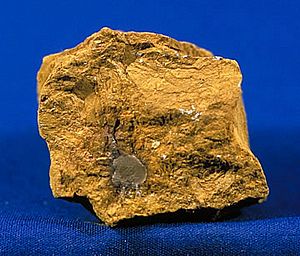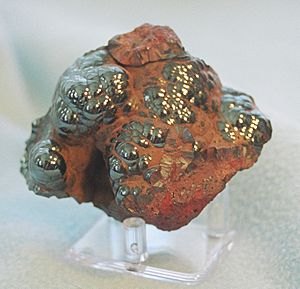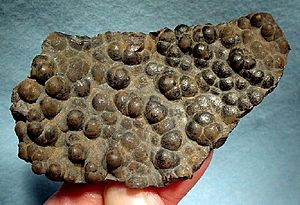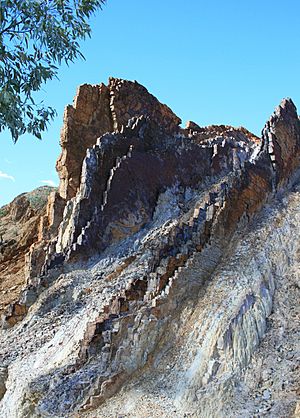Ochre facts for kids
| This box shows the colour ochre. |
|---|
Ochre is a special kind of natural earth pigment. It's usually a golden-yellow or light yellowish-brown color. The word "ochre" comes from the Greek word ochros, which means "yellow". Ochre gets its color from natural minerals called hydrated iron oxide.
Contents
What is Ochre?
Ochre is a natural pigment found in the ground. It contains minerals like Limonite (which makes yellow ochre) and Hematite (which makes red ochre). When yellow ochre is heated, it can turn into red ochre. Another mineral, Goethite, is the main part of brown ochre.
These colorful clays have been used by people for thousands of years. They are found all over the world, like in the clay hills of Roussillon, Vaucluse in France.
Ochre in Ancient Times
People have used ochre for a very long time. Scientists have found pieces of ochre with designs on them in South Africa. These pieces are about 75,000 years old!
Ochre in Prehistoric Art
Ochre was very important for early humans.
- In Australia, ancient burials from 40,000 years ago used red ochre.
- In Wales, a burial from about 33,000 years ago, called the Red Lady of Paviland, was covered in red ochre.
- Cave paintings in France and Spain, like those in Pech Merle and Altamira cave, used red and yellow ochre. Some of these paintings are over 25,000 years old.
- The famous Lascaux cave in France has a painting of a horse made with yellow ochre. It is about 17,300 years old.
Some experts think that red ochre was used in burials to show a return to the earth. It might also have been a symbol of new life, with the red color standing for blood.
Ochre in Ancient Egypt
In Ancient Egypt, yellow was linked to gold. Gold was seen as eternal and strong. The Egyptians believed their gods had skin and bones made of gold. Yellow ochre was used a lot in tomb paintings. Men were often shown with brown faces, and women with yellow or gold faces.
Red ochre was also used in Ancient Egypt. Women used it as a blush or lip gloss. Ochre lines were found on the Unfinished Obelisk in Aswan. These lines marked where workers should cut stone. Ancient Egyptians also used ochre clays as medicine. This use is described in the Ebers Papyrus, an old Egyptian medical text from about 1550 BC.
Ochre in Ancient Greece and Rome
Ochre was the most common paint for walls in the ancient Mediterranean world. In Ancient Greece, red ochre was called míltos. In Athens, public slaves would sweep the Agora with ropes dipped in míltos. If citizens stayed there instead of going to the Assembly, their clothes would get stained. This stopped them from wearing those clothes in public again.
The best red ochre in classical times came from a Greek colony near modern Sinop, Turkey. This special color was called "sealed Sinope." The Romans used yellow ochre in their paintings to show gold and skin tones. It was also used as a background color. You can see it often in the murals of Pompeii.
Ochre in Other Cultures
The ancient Picts in Britain were said to paint themselves "Iron Red." This practice might have been common among the Celts in the British Isles.
Ochre Use Around the World
Ochre has been important to many cultures across different continents.
Australia
Aboriginal Australians have used ochre for thousands of years. They use it for body decoration, sun protection, and in art. Ochre helps preserve animal skins too. At Lake Mungo, burial sites show bones painted with red ochre. Some of these are as old as 60,000 years. Ochre pigments are found all over Australia, especially in the Western Desert and Kimberley regions.
New Zealand
The Māori people of New Zealand used ochre mixed with fish oil. Ochre was their main coloring agent. They used it to paint their large waka taua (war canoes). Ochre helped stop the wood in canoes and meeting houses from drying out. Missionaries later thought it could last for 30 years. Māori women also smeared ochre on their faces to keep insects away.
North America
In Newfoundland and Labrador, the Beothuk people used red ochre. This led Europeans to call them "Red Indians." The Maritime Archaic people also used it, as seen in graves at Port au Choix. In the Eastern Woodlands of Canada and the US, ochre was widely used. The Red Ocher people complex refers to a time around 1000-400 BC when ochre was very important. Native Americans like the Tongva and Chumash people in California also used red ochre as body paint.
In Newfoundland, red ochre was popular for painting fishing buildings. People mixed dry ochre with liquids like seal oil or cod liver oil to make paint. Seal oil was thought to give a purer red color. Cod liver oil made a more brownish-red.
Africa
Red ochre has been used in Africa for over 200,000 years. Women of the Himba people in Namibia mix ochre with animal fat. They use this mixture to color their skin and hair reddish. Men and women of the Maasai people in Kenya and Tanzania also use ochre in a similar way.
Renaissance Art
During the Renaissance, yellow and red ochre paints were very popular. Artists used them for painting on wood panels and for frescoes (wall paintings). The colors of ochre varied depending on where the clay came from. For example, red earth from Pozzuoli near Naples was salmon pink. The pigment from Tuscany was a darker reddish-brown called terra di siena, or sienna earth.
The painter Cennino Cennini wrote about how to use ochre paints in his famous book on painting. In Malta, red ochre paint was often used on public buildings.
Images for kids
See also
 In Spanish: Ocre para niños
In Spanish: Ocre para niños












